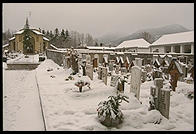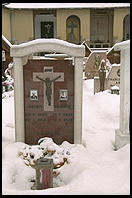
Dolomites
of Italy by Philip Greenspun; created 1995
James Bond, Hedda Gabler, Inspector Clouseau and Pope John Paul II love these mountains.
 Once part of the ocean floor,
the limestone massif was pushed up to a height of 3,341 meters above sea level
when the European and African continental plates collided. During the 60 million
years since that uplift, the mineralized coral has been eroded by wind, snow, and
rain into steep cliffs and narrow spires. Celts and Romans clashed here during
the reign of Emperor Tiberius. Some of the victorious Roman soldiers founded
villages in the valleys of what they knew to be the Montes Veneti or
Alpes Tridentinae. Local dialects echo with the sounds of Latin in the
form of Romansch (Ladin). In 1789,
Dieudonné
Sylvain Guy Tancrède de Gratet de Dolomieu, a French geologist,
visited and his mineral study eventually resulted in the mountains being named
after him (replacing earlier names such as Venetian Alps, the Cadore, Fassa and
Trent Alps, Souh-Tyrolean Alps, South-Eastern Tyrolean Plateau, Adige-Piave
Group, Eastern Adige Alps, etc.).
Once part of the ocean floor,
the limestone massif was pushed up to a height of 3,341 meters above sea level
when the European and African continental plates collided. During the 60 million
years since that uplift, the mineralized coral has been eroded by wind, snow, and
rain into steep cliffs and narrow spires. Celts and Romans clashed here during
the reign of Emperor Tiberius. Some of the victorious Roman soldiers founded
villages in the valleys of what they knew to be the Montes Veneti or
Alpes Tridentinae. Local dialects echo with the sounds of Latin in the
form of Romansch (Ladin). In 1789,
Dieudonné
Sylvain Guy Tancrède de Gratet de Dolomieu, a French geologist,
visited and his mineral study eventually resulted in the mountains being named
after him (replacing earlier names such as Venetian Alps, the Cadore, Fassa and
Trent Alps, Souh-Tyrolean Alps, South-Eastern Tyrolean Plateau, Adige-Piave
Group, Eastern Adige Alps, etc.).
Italy's 1915 entry into World War I on the side of the Allies turned the Dolomites into a battleground with the Austro-Hungarian empire.
Today the Dolomites straddle the border between Austria and Italy and share the cultures and languages of those countries. They are very popular for skiing from November through April and for hiking July through September.